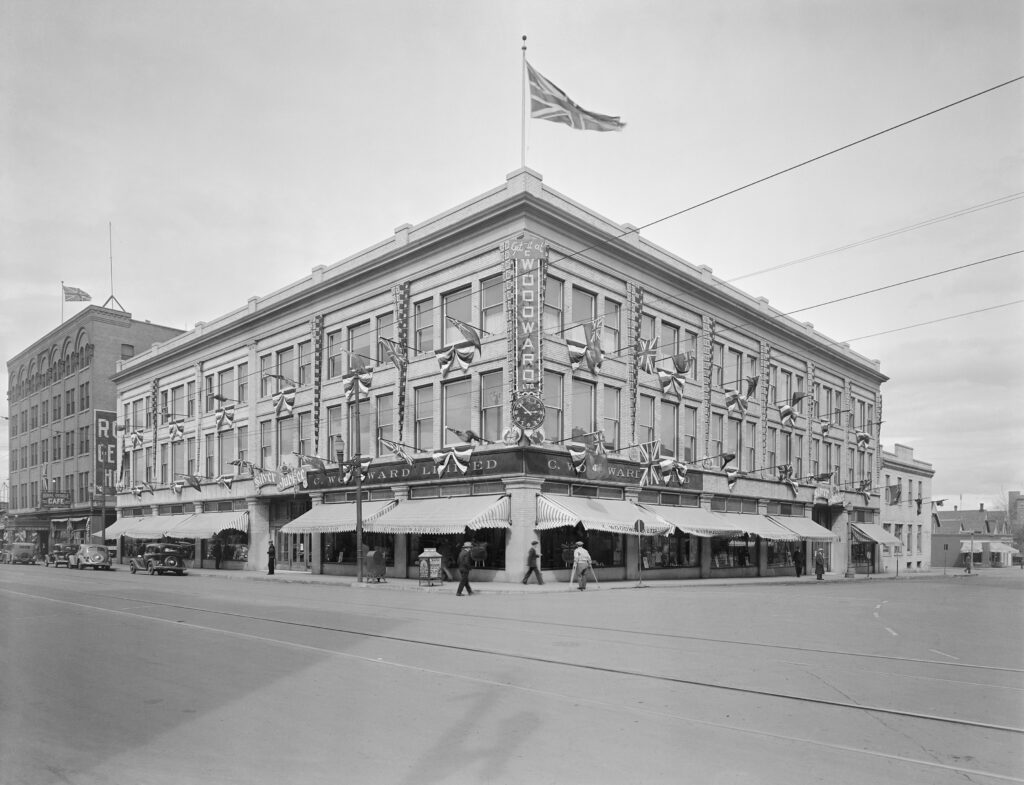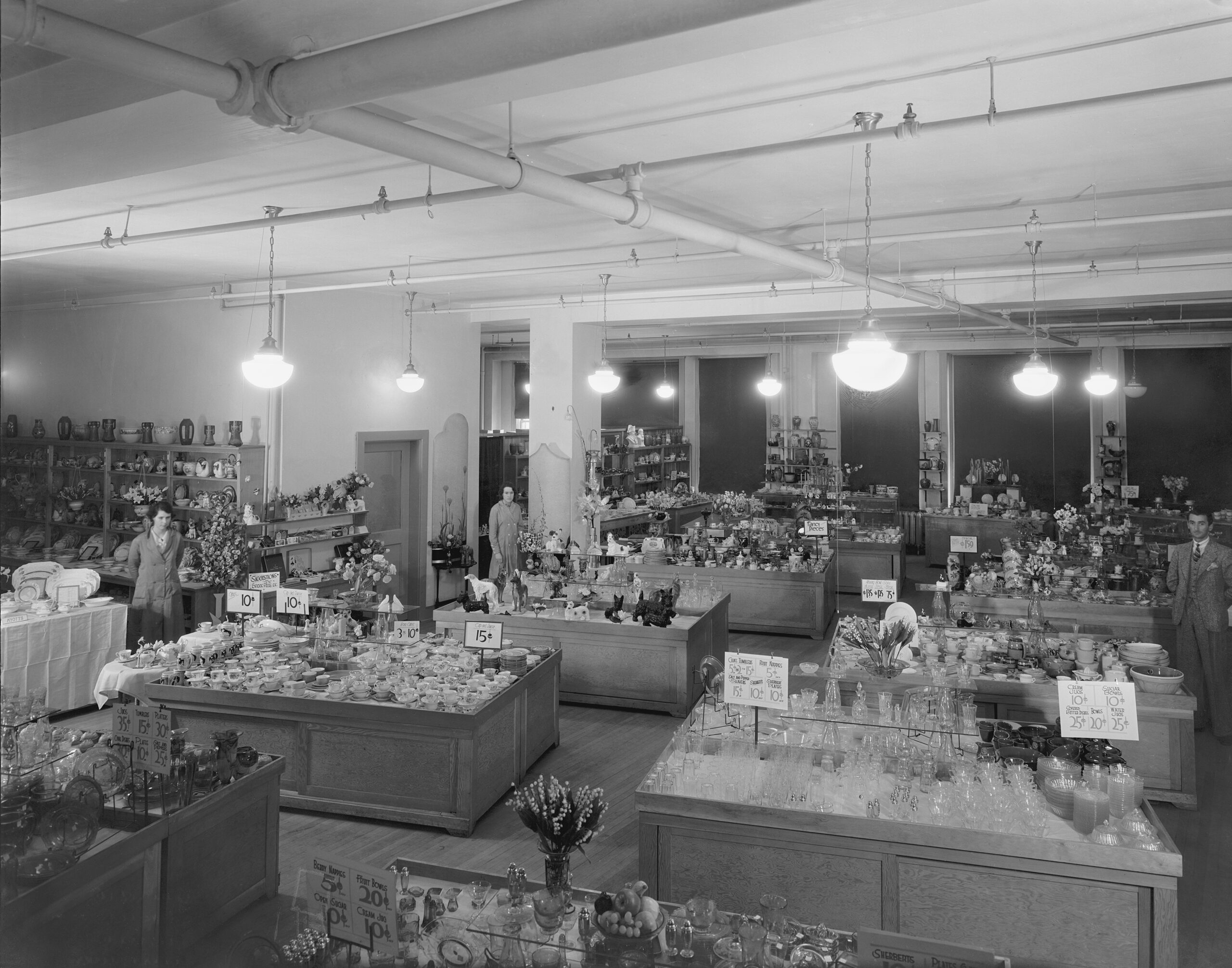As a kid, I remember the downtown Woodward’s store as a treasure trove of sights, sounds, and smells. It was the place women in smart uniforms navigated elevators up and down the six floors and their $1.49 Day was a retailing fixture every Monday (and later Tuesday).
I can still whistle from memory the Woodward’s radio jingle that drifted over the radio airwaves and into our memory banks 50 years ago. “Dollar forty-nine day, Tuesday. Dollar forty-nine day, Woodward’s.”
Those elevators, a bank of them at the back wall of the store, had nifty two-part doors that the operators would pull open and closed – first the cage part, with what looked like expanding diamonds, and then the solid door. The up-and-down movement of the elevators was controlled with swivel handles that, to my ten-year-old eyes, looked like something from science fiction. Sometimes I would get in just to ride and get out at each floor and wait for the next one. That is, until my mother would tell me to stop messing around.
Merchandise sprawled over six floors of delight with everything from clothing to hardware, housewares, shoes, sporting goods, furniture, kitchenware, and the most amazing toy department. There was an enormous food floor in the basement, too, with all manner of exotic and imported delights.

This one-of-a-kind department store opened on October 15, 1926, on the northeast corner of 102 Avenue and 101 Street and operated until 1974. When Eaton’s opened its new store across the street in 1940, and Zellers moved in to the main floor of the Tegler Building just to the south, this intersection became downtown Edmonton’s retail hub – and stayed that way for decades.
The story of Woodward’s reaches back to 1902, when Vancouver merchant Charles Woodward founded Woodward Stores Ltd. on Hastings Street. Shoppers could find it by the big neon “W” on the roof. Woodward expanded eastward and purchased properties in several Canadian markets, including Edmonton, where he bought land in 1920 and 1921, assembling most of the block on the east side of 101 Street and 102 Avenue.
A July 25, 1921, article in the Edmonton Bulletin reported that Woodward was making arrangements for the construction of “one of the most modern buildings institutions in Western Canada. Mr. Woodward has placed Edmonton as one of the most important and progressive cities in western Canada.” 1
As Edmonton and the country were getting back on their feet after World War I, the 1920s became a decade of rapid technological change and earnest reaching for a better future.
Electricity was catching on in a big way, natural gas came along in 1923, and the first ‘talkie’ motion picture was shown in 1928.
But some things hadn’t gone out of style, like the public’s quest for fair prices, value, and friendly service. Shoppers of the day bought many of their goods at the city’s clothing, appliance, and hardware retailers. Then Charles Woodward came to town, bringing Edmonton a new concept that brought all of it under one roof – a department store that was to change the way citizens shopped.

Construction on his store began in early 1926, built by local contractors, using local labour and, where possible, local materials. “Although foundations have been put in place for a ten storey structure, only three floors have been erected at the present time,” the October 13th, 1926, edition of the Edmonton Bulletin reported. “But the structural steel and reinforced concrete store is one of the most up-to-date in the West, while the spaces between the columns being exceptionally large, give the maximum of floor space and height.”
“Two spacious entrances are provided for the general public, one opening on to 101st Street and the other on to 102nd Avenue,” the Bulletin story said. With 60,000 square feet of floor space, the latest in electric lighting fixtures, modern heating systems and show windows which are unequalled anywhere in the city, the new store was the toast of the town.
“Ceilings are high, ventilation is excellent and the basement with terrazo floor and faced with polished granite from British Columbia is one of the finest store basements in Canada,” the Bulletin observed. Business was good right from the beginning and, even as the economy faltered in the Great Depression and wartime, Woodward’s kept chugging along, with additions completed in 1929, 1932, and 1940.
Another expansion announced in 1946 wasn’t completed until 1948 because of a shortage of materials and trades, especially bricks and bricklayers, in post war Canada. The 1940 work added a stainless steel canopy to the front of the building and a “Grocerteria,” a “serve yourself method of selling quality foodstuffs,” as a June 5, 1943, newspaper ad put it. It was a “leading food floor” where “customer satisfaction, friendly service and consistently low prices are assured.”

By the time the store’s growth was complete in 1949, Woodward’s occupied the entire block between 100A Street and 101 Street with 182 feet of frontage and another 147 feet along 101 Street. The building that had been three stories became five and then six with more than 200,000 square feet of space. That’s how it served into the 1970s.
During cold and rainy weather, people waiting for the bus would huddle in the vestibule between the heavy glass doors. In the basement, shoppers would buy their groceries and pause for a cup of coffee and a sandwich at the lunch counter. People went to Woodward’s to shop, to meet their friends and to just enjoy the ambience and the activity.
That’s how I remember it: a place of life, and discovery, friendly smiles and childhood misadventures. My mom worked at the Palace of Sweets on Jasper Avenue, and we would often walk over during her lunch break for a bite to eat at the Food Floor and some shopping. I cherish the memories of the ever helpful and pleasant people (800 of them in its peak days!) who made the place hum with excitement.
The beginning of the end came in May 1967 when Woodward’s announced plans for a $35 million, 40-storey Edmonton Centre complex with a new department store and office tower on the site. The modern development meant the demolition of Edmonton’s glorious 1912 Court House, acquired the previous year in a land swap with the provincial government. And it meant the wrecking ball for the 1926 Woodward’s building, too.

When the store closed for good in May 1974, the Edmonton Journal remembered its passing with reverent sadness: “There were times without number when this hulking structure seemed a six-level echo of Grand Central Station gone mad.”
The bedlam had been replaced by a forlorn emptiness, an editorial observed. “No scuffling of feet on terrazzo stairs, no rattle of cash resisters and no Niagara roar of customer chatter. From credit office above to coffee shop below, the dead store was an incredible vacuum. The oak rails of the wrought iron stair guards, hand-rubbed a million times over, had been polished for the last time and dust was collecting.” Demolition began that summer and the site was wiped clean by the end of the year.
Members of the Woodward family remained in charge of the company for nearly its entire history. When Charles died in 1937 at age 84, the power passed to his son William, who had started with the firm as a bookkeeper in the early 20th century. William, who was named Lieutenant Governor of British Columbia in 1941, remained president until 1956. William’s son Charles (known as “Chunky”) became the company president in 1956 and held the post until 1988.
By the time the business faltered in the early 1990s, it comprised 26 department stores and 33 Woodwynn discount stores in Alberta and B.C. The Hudson’s Bay Company acquired Woodward’s in 1993, bringing to an end a Canadian retail story that had stretched virtually the length of the 20th century.
The $1.49 Day jingle lived on, too, and has found a new audience in digital form. It was written in 1958 by Tony Antonias, who was CKNW Radio’s creative director at the time. 2 Antonias went on to work 40 years at CKNW, and he died in 2019 at the age of 89. 3 I am whistling it still.
Lawrence Herzog © 2021
[1] City of Edmonton Archives newspaper clippings files.
[2] https://www.vancourier.com/community/woodward-s-famous-1-49-day-jingle-celebrates-60-years-video-1.23183912.
[3]https://globalnews.ca/news/4894245/tony-antonias-writer-of-woodwards-1-49-day-jingle-dies-at-89/.

